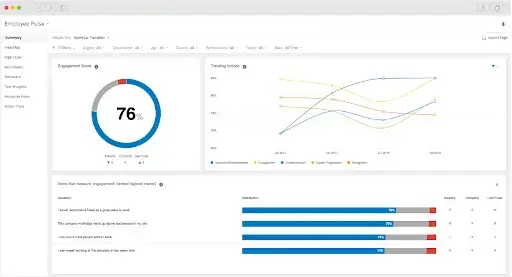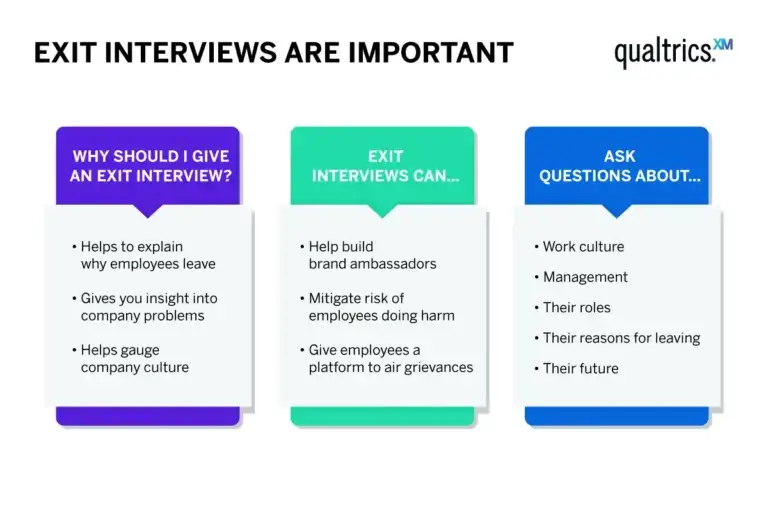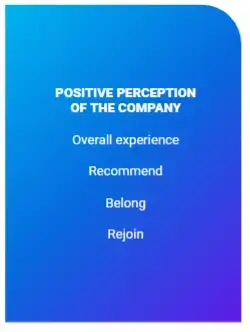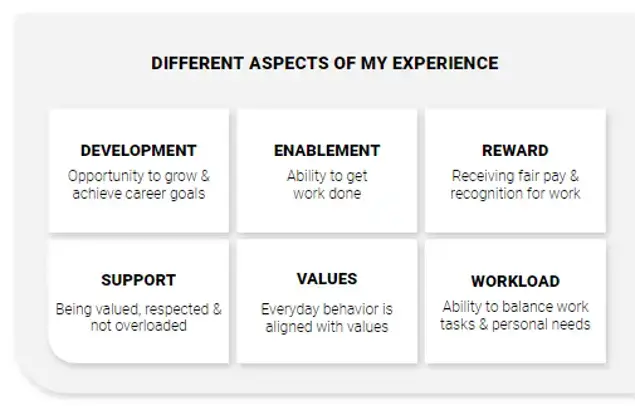Written by: Ruth D’Alessandro
Fact Checked by: Jake Outram
A departing employee has handed in their notice. Maybe they felt that this wasn’t the right company for them. Maybe they got a new job offer. Maybe you decided their time with the company had simply run its course or they fancied a career change. Maybe you could have helped keep them longer at the company? Who knows?
You should know. Pinpointing why people leave is crucial to your company’s success. People exit organizations every day: it’s called employee turnover and is part of every employee’s lifecycle.
But where it is ‘unwanted attrition’ – losing high-performing employees in critical roles for reasons that could have been prevented – it’s an urgent business issue.
High employee turnover affects a company’s bottom line: The average cost of replacing just one employee can range from one-half to two times their annual salary (Gallup, 2019). Losing high-performing and engaged team members can affect other employees, your brand value, and your ability to deliver high-quality service and products.
So when an employee resigns, companies should have an exit process that combines:
- Exit surveys
- Exit interviews
Get started with our free Employee Exit Interview Survey template
What is an exit survey?
An exit survey, taken at the end of an employee’s time with you, is the best way to find out at scale why people leave your organization. You can identify trends, learn from them, and take action to reduce attrition, such as more robust hiring strategies for new employees or improvements to your company culture, working practices and management styles.
Exit surveys gather honest feedback and understand the reasons behind an employee’s departure.
It’s a chance to learn from leavers’ experiences – the good and the bad. Ideally, exit surveys are supplemented with one-to-one interviews with selected leavers. You don’t have to interview everyone.
What is an exit interview?
Most companies conduct exit interviews. These are qualitative one-to-one interviews with selected departing employees, especially regretted leavers, to gather honest feedback and understand the reasons why they are leaving.
An exit interview formally closes the employee/employer relationship in a constructive and helpful way.
What causes unwanted attrition?
There can be many reasons for unwanted attrition, including:
- Employee job dissatisfaction
- Employees not feeling valued or recognized
- Misleading job description
- Lack of clarity on objectives
- Underwhelming pay and benefits, especially in the current high inflation environment
- Lack of advancement opportunity
- Lack of confidence in the business direction or quality of leadership
- Conflict with a co-worker or manager
- Lack of resources or information to do the job
- Workplace flexibility and options for hybrid working
- Work-life balance
- Career break
- Pursuing further education
These are all things that can build up over time, and the trigger to leave can happen at any stage in the employee lifecycle. In fact, post-Covid, a common pain-point for organizations is attrition among new joiners.
The key to reducing unwanted attrition is to understand:
- Why it happens
- What you can do to prevent the same things from happening to other high-performing employees
Well designed exit surveys and dashboard reports will provide you with this information.

Why is listening to feedback from leavers important?
The hiring process is expensive and can take a long time. If at the end of it you employ people who stay with your company only briefly:
- You waste time and money on recruitment
- The leavers may never have fully ramped up in the role
- Every time someone leaves, a bit of company knowledge or process goes with them
- Leavers may also be detractors, affecting your company’s reputation
- There is additional, prolonged pressure on the other team members who are trying to manage with lower headcount
- You are back at the start of the recruitment process
By providing departing employees with the opportunity to give honest feedback, you can gather valuable insights to improve the employee experience for both current and future employees.
An exit survey is a means to an end. The goal is not to prevent the employee from leaving. Instead, it is to learn and use it to gain insights to help retain talent, prevent bad hires, improve management practices, and ultimately drive better organizational performance.

Start gaining insights with our Employee Exit Program
What are the goals of an effective exit survey?
An effective exit survey yields valuable information. It:
- Provides first-hand employee experience data and actionable insights on their environment, team, management, role, and company culture.
- Reveals whether the former employee would promote your organization to other people externally
- Helps you understand why an employee chose to leave, so you can see how this aligns with your company’s attrition risk profile
- Identifies any issues or areas within the business that need improving
What makes a good exit survey?
Robustly designed exit surveys should:
Have a purpose stated right at the beginning
‘Help us understand more about your decision to leave’
Thank the employee for their service
‘We really appreciate the work you’ve done with us, and we’re sorry to see you go!’
Encourage honest feedback
By using online surveys, which result in more candid feedback (as well as useful data) than a more traditional face-to-face interview
Not shy away from asking tough questions
Particularly ones that shine a light on potential breakdowns within your business
Combine quantitative and qualitative feedback
Quantitative feedback allows you to track trends over time, compare feedback across the business and link feedback to KPIs, such as staff turnover costs, to demonstrate the return on investment (ROI) of your improvements. Use text fields to elicit rich detail and nuances about an employee’s decision to leave. Text analytics software can automatically process language and analyze sentiment to allow you to gain insight into what your exiting employees really think.
Are automated through a digital open door
By linking an employee feedback platform to your HRIS to automatically send a request for feedback when an employee hands in their notice, reducing the amount of time human resources people need to spend manually administering the surveys
Understand the impact of attrition
By correlating data from different sources. For example, by tying in your exit interview data with 360 performance data or employee engagement data, you can start to identify regrettable and non-regrettable attrition
Pinpoint certain teams, roles, or demographics
With higher attrition rates and take steps to not only understand why they’re leaving, but how you can take action to prevent it from happening in the future
How to gain maximum insight from exit surveys
- Make the exit survey part of the standard off-boarding process and use automated systems to reduce the workload
- Conduct the exit survey after employees decide to leave, but just before physically leaving the organization. Organizations typically collect exit survey feedback about 1-2 weeks before an employee’s last day of work. Employees are less likely to respond to the survey once they have walked out of the door
- Keep employee exit survey questions short and simple by focusing on evaluating different job components and identifying where change is necessary
- Assure the respondent that their feedback is confidential. Not to be directly shared with their manager, and most importantly, you must emphasize that it will not affect any reference they may seek in the future
Key themes to measure in an exit survey
Research by Qualtrics into employee turnover has identified four key performance indicators (KPIs) that are important to measure through an exit survey:
1. Experience vs. expectations
“Overall, to what extent did your experience working at this company meet your expectations?”
2. Likelihood to recommend
“I would recommend this company to people I know as a great place to work.”
3. Organizational belonging
“I felt a sense of belonging at this company.”
4. Likelihood to rejoin

“I would consider rejoining this company.”
These allow an organization to understand how much the person leaving:
- has had a positive experience and positive perception
- Is exiting as an advocate or a critic
Qualtrics also identifies six dimensions, or topics, that drive a positive employee experience:

1. Development
Growth is a fundamental human need. Seeking further development opportunities is still emerging as a top driver for finding alternative employment.
It’s measured with: meaningful career development discussions, regular conversations about performance, and giving opportunities to improve skills
2. Enablement
This is having the ability to get work done. When employees, especially for high performers, don’t feel enabled, this can be a great source of frustration. You need to understand if employees had the right resources and physical work environment they needed to be productive.
It’s measured by looking at how: the job makes good use of skills and abilities, the processes support productivity, managers help to remove barriers, and workspace and technology supports productivity.
3. Reward
Receiving fair pay and recognition for individual contributions at work is the backbone of the employee and employer relationship. When these don’t align, they can compound other perceived issues in the employment relationship.
It’s measured by looking at fair pay, benefits that meet employee needs, and meaningful recognition.
4. Support
Employees must be valued, respected and not overloaded with work. Today’s workforce increasingly seeks job opportunities where they have the flexibility to manage their workload alongside their personal life.They also seek out work environments where there are high levels of respect and trust.
Support is measured by: trusting relationships, managers treating teams with respect, the amount of support to adapt to organizational changes, and how much managers care about well-being.
5. Values
Our 2023 Employee Experience Trends Report found that being employed isn’t just about having a job – it’s a part of a person’s value system.
When employees feel that their organization embodies these values, they’re 27% more likely to have higher engagement scores, and 23% more likely to stay working for more than 3 years.
Departing employees are actually leaving a culture that’s not a good fit for them. Many employees choose to work for organizations whose culture aligns with their own personal values.
Measure values with: open and honest communication, pride in the company’s impact on the world, and checking whether management behavior is consistent with company values.
6. Workload
It’s essential people can balance work tasks with their personal needs. It’s no longer enough to engage employees and encourage them to work hard. Even engaged employees who don’t feel they have a good work life balance are unlikely to see a long-term future with the organization.
Measure whether workload is manageable and flexible enough to meet work and personal needs.
This model is complemented with questions that ask the employees their reasons for leaving, plus a free-text question to understand what (if anything) could have been done to keep them. There are also demographic questions to help understand the differences in employee experiences across different segments of the organization.
The exit interview process
Exit interviews are generally only used for selected employees, and they follow on from an exit survey. Follow our employee exit interview tips to collect constructive feedback and make sure people leave on a positive note.
Do’s and don’ts for the exit interview process:
Do:
- Make exit interviewing part of your HR policy so when an employee leaves, they know what to expect
- Plan the meeting – you can give the departing employee an exit survey first, following up with a one-to-one meeting
- Ensure full confidentiality for the departing employee
- Remind the employee of their obligations to keep confidentiality about the company
- Ask open questions that require more detail than yes or no answers
- Focus only on the company, with a view to improving it and moving it forward
- Involve the employee’s direct manager
- Analyze the information collected in the interview and act on its findings
Don’t:
- Require every employee to have an exit interview – the process should be voluntary
- Try to persuade the employee to stay – the time of resignation was the opportunity for that
- Wait until the employee’s last day – they will be distracted and disengaged
- Ask about specific people or specific incidents
- Give your own opinions about an individual or incident
- Allow the discussion to descend into office gossip
- Forget that a positive, effective exit interview can create a future company ambassador
When you use Qualtrics’s EXM Exit solution not only will you understand the main reasons why employees leave your organization, you’ll also gather candid feedback. You’ll learn from these insights what you can do to improve the employee experience and minimize regrettable attrition.
30 best example exit interview questions for employee exit surveys – and why
To get the fullest picture of the employee experience and improve retention, pick questions from this Top 30 list of sample exit interview questions and the reasons why you should ask them. They cover:
- The role
- The pay and package
- The reason for leaving
- The manager
- The team
- The workplace and culture
- The organization as a whole
Example questions – the role
- How long did you work in this role?
Turnover among long-serving employees, who have accrued knowledge and skills, has a greater impact than the loss of a relatively new hire. There may be specific trends or issues prompting resignations among valuable current staff.
- How accurately was the role described to you before you joined the organization?
Assess your hiring, interview, and onboarding processes, and the role they played in selecting the right candidate. This can also yield data about the job description
- How much did the job role change after you were hired?
Certain circumstances may require an employee to take on new or different responsibilities. Find out what these are and the impact they had on the employee by asking them what changed and why.
- How reasonable or unreasonable was the workload for this role?
Burnout and overwork can be a factor in unwanted turnover. A business could be over-estimating an employee’s capacity for more work, especially if they’re seen as high-performing top talent.
- What were the best and worst areas of your job?
Each employee values different areas of a job, and it may help to understand this employee’s perspective to see obvious patterns. Good aspects can be promoted to keep the role interesting.
- How could we have supported you to continue in your role?
There may be potential areas (poor IT systems, lack of training or tools, etc) that weren’t working in the employee’s role. Help retain your next hire by resolving these issues for a better experience.
- Given the role’s responsibilities today, what things should we be looking for in your replacement?
No one knows the job better than the employee that did the job day in, day out. Their insights can help you update the job description and target the right replacement candidates.
- Would you consider coming back to work in this role in the future?
Rehiring an outstanding employee could be an option if the problems are fixed. Find out whether they are still open to this role and want to hear about future opportunities.
Example questions – the pay and package
- How fair did you feel your total compensation package (pay + benefits + any equity) was compared to other organizations?
This question helps you understand whether you’re competing well in the wider employer market. It may be that the employee likes working for you but has received an offer that’s too good to refuse.
- How good or bad was your benefits package?
Pay is generally a contributing factor to employee dissatisfaction. Other things like low engagement and alignment of personal values with company values, can matter more. Track to what extent pay and the package played a role in the decision to leave.
- Which benefits did you take advantage of?
Understand why an employee used some benefits over others, and where making changes could help benefit uptake. This also helps make your benefits stronger for current and new employees.
Example questions – the reason for leaving
- What was your main reason for leaving the company?
Sometimes, the best way to find out why somebody left is simply to ask them. Employees know their own minds about resigning – intent to leave and actually leaving are strongly correlated.
- Why did you begin looking for another job?
This is phrased to focus on the employee’s wants and desires within the new position. If they’re looking elsewhere for this, you may want to investigate bringing it to your company.
- Was there a specific event or person involved with your decision to leave?
50 percent of Americans have left a job to “get away from their manager at some point in their career”, according to a Gallup employee engagement survey. If employees are resigning because of a direct cause, this needs immediate attention.
Example questions – the managers
- How much did your managers’ actions match their words – ex. did they do what they said they would?
An employee’s relationship with their manager can have a huge impact on their engagement and job satisfaction. Trusting your manager to follow up on what they say helps support a good working relationship.
- What challenges were present when working with your manager?
An employee’s upwards feedback can help strengthen the management of your replacement hire. It can also highlight when to explore training options or review performance levels.
- How were feedback and ideas exchanged and did you feel it worked?
Employees that receive constructive feedback and are able to suggest ideas back can feel valued and supported. As they progress in their role, employees feel greater job satisfaction.
Example questions – the team
- What was the team atmosphere like?
The dynamics within a team are unique, based on each person’s personality, role, and background. This gives you an idea of the overall picture of the employee’s team and how they work.
- How often did you see your team or have team meetings?
Team collaboration can impact an employee’s job if there is not adequate opportunity to arrange meetings and connect. Managers can review practices to structure team contact time each week.
- Who made a real difference to your employee experience, if anyone?
There are some employees within teams that naturally hold teams together and make an extra effort to help others. These employees are worth knowing and appreciating for making their team better.
- What advice would you like to give to your team?
The advice from the employee could point to a viable or innovative solution. As advice tends to be framed positively, it’s more likely to be constructive and helpful.
Example questions – the workplace and company culture
- How safe or unsafe was your working environment?
Employee safety and how it is perceived within a company culture can have strong positive or negative effects on employee engagement – which in turn is a driver of retention. It’s essential employees feel safe.
- How would you describe the organization’s culture?
Your view of the company culture at a senior level can vary from the staff working on the ground. See if the cultural values are clear, or if more needs to be done to establish them within the business.
- Who would you speak to in the organization about your concerns?
Explore how connected the employee was and who was in their networks. It will also show well your staff is communicating with each other at a peer-to-peer level, and where this is not happening.
- Have you ever experienced any discrimination or harassment within the workplace?
Harassment and discrimination are serious offenses that must be handled correctly to protect the organization and its employees. If the employee experienced issues, find out why this went
Example questions – the organization as a whole
- On a scale from 0-10, how likely are you to recommend [COMPANY NAME] to a friend or colleague?
This question supplies employer NPS data, which provides insight into loyalty and engagement. Engagement, in particular, is negatively correlated with staff turnover, so investigating that could change.
- How fairly or unfairly do you think this company treats all of its employees?
An employee’s perception of organizational justice (i.e. how fairly staff are treated) can have an impact on the likelihood of turnover – if the perceived level of justice is low, it could be a factor to consider.
- What would you change about the company?
You’ll find more information on why the departing employee is leaving, or gain the employee’s unique perspective of the company from their interactions with customers, suppliers or other peers.
- In your opinion, where does the organization perform well?
Areas perceived as positive enough to warrant complimenting by a departing employee are likely to be shared in a positive light in the future. Verify the results and explore these ‘gems’ in more detail.
- How can we improve our training and development?
Maybe the employee liked learning in a specific way or using a specific training option. Or did they learn outside of the available training on offer? This could improve the way training is delivered.
Get started with your own exit interview survey
If your company has experienced high turnover, low employee satisfaction scores or you want to boost employee retention, begin to understand why people are leaving by using our exit interview survey software. We have a free exit interview survey template, designed to best practices.
The insight from employees, who have nothing to lose and want to share their honest experiences, can highlight areas for improvement and underlying issues.
Get started with our free exit interview survey template